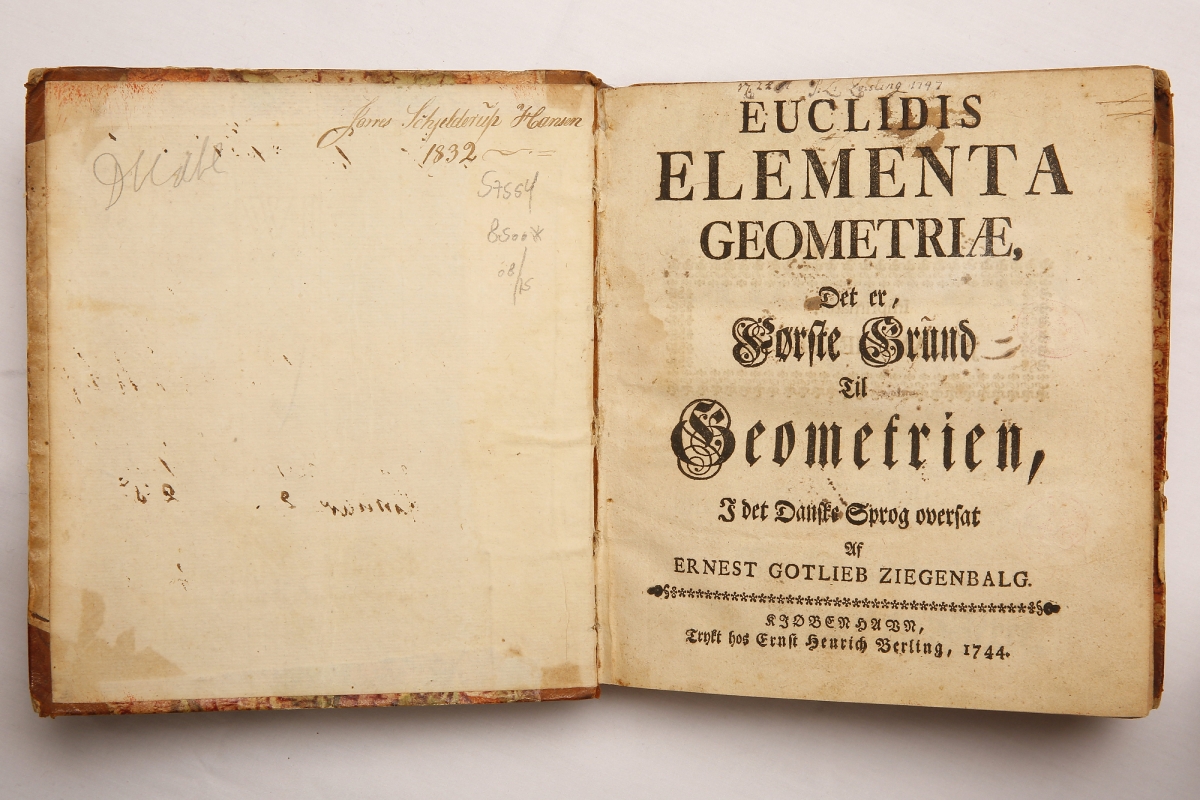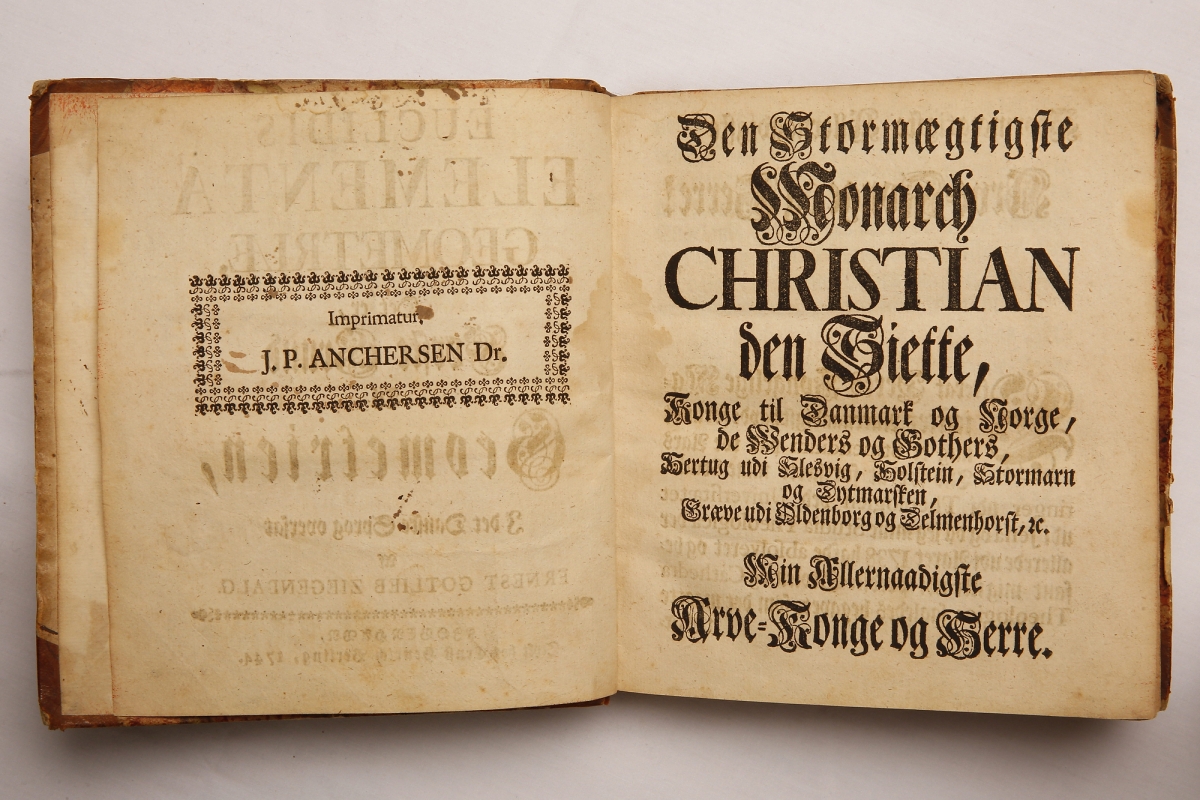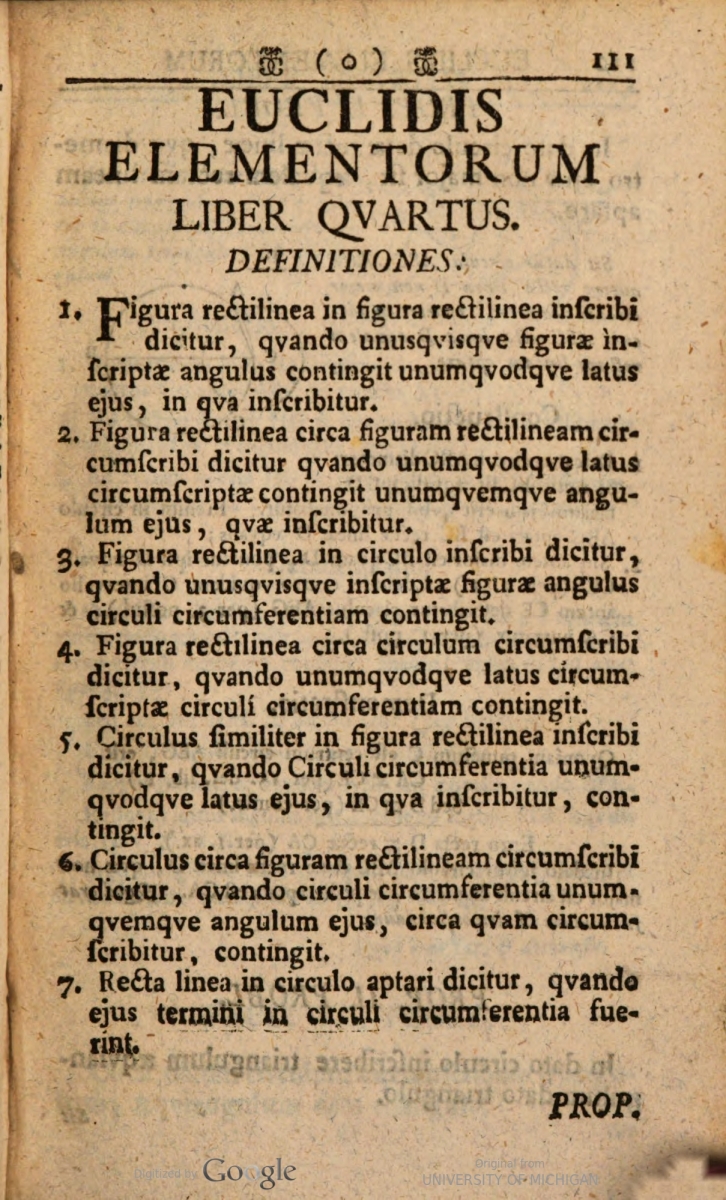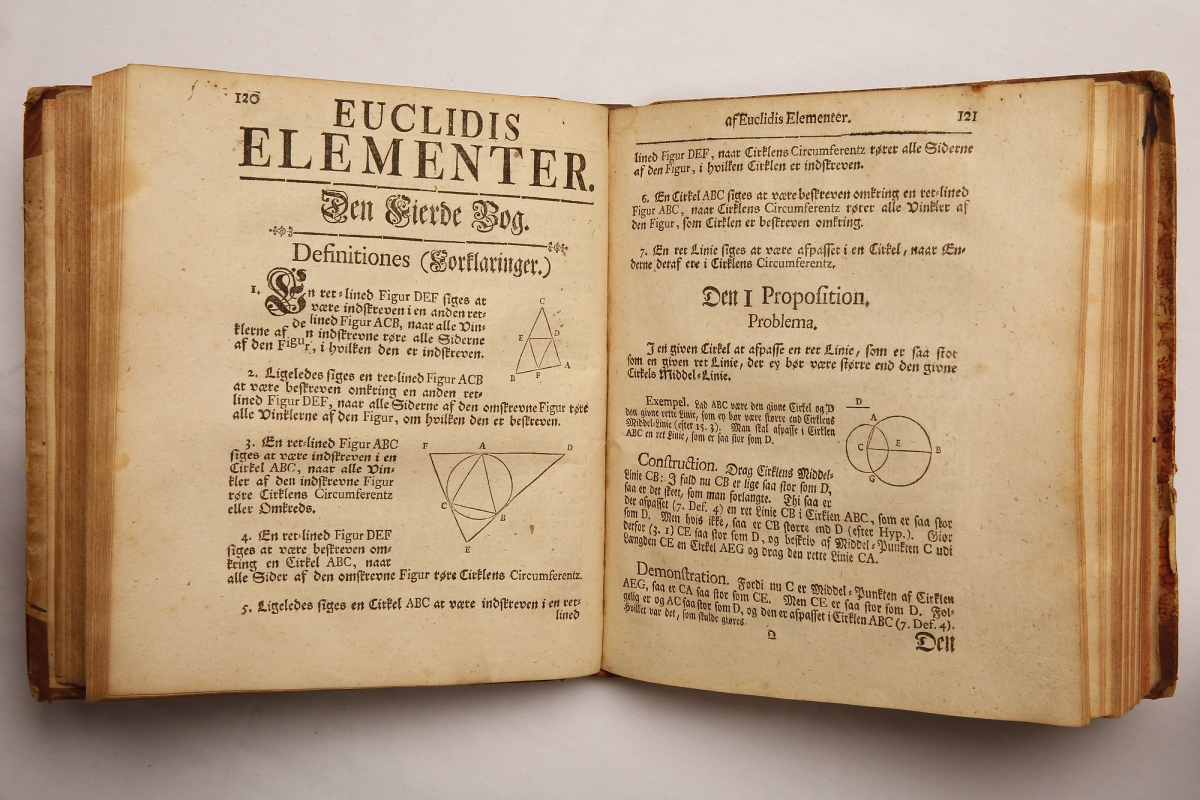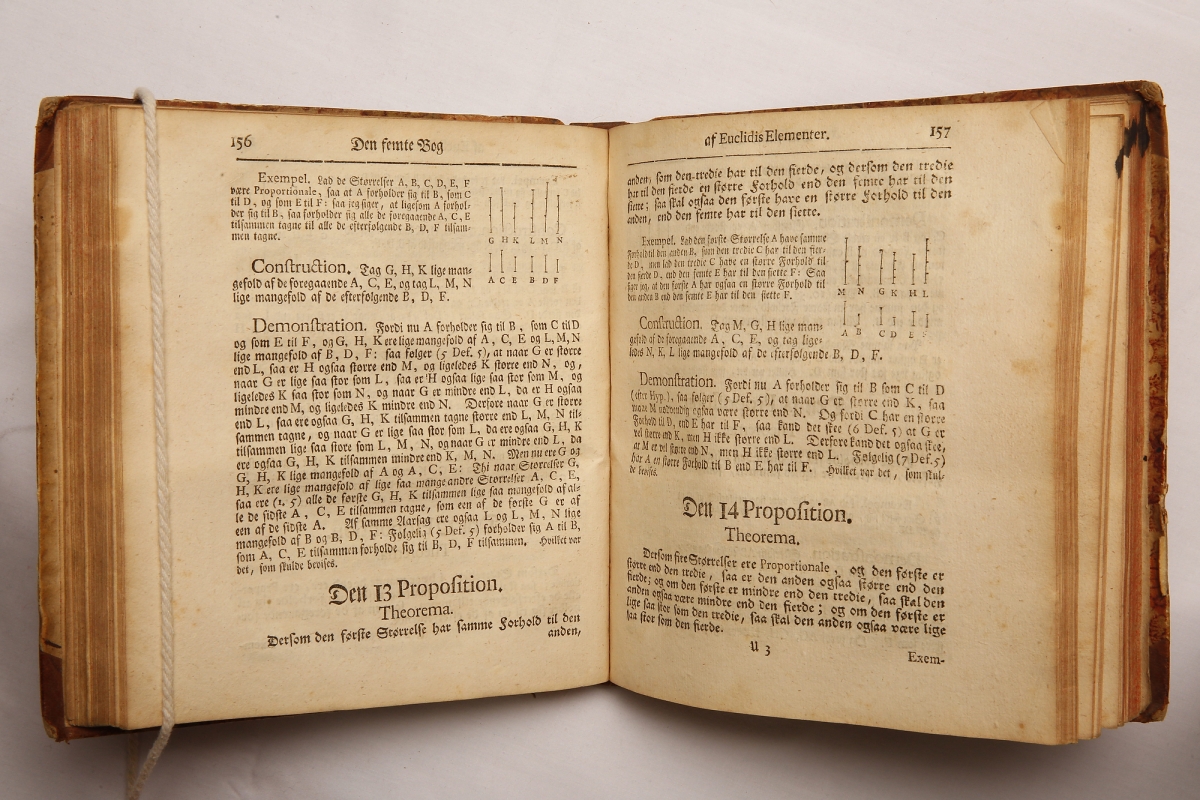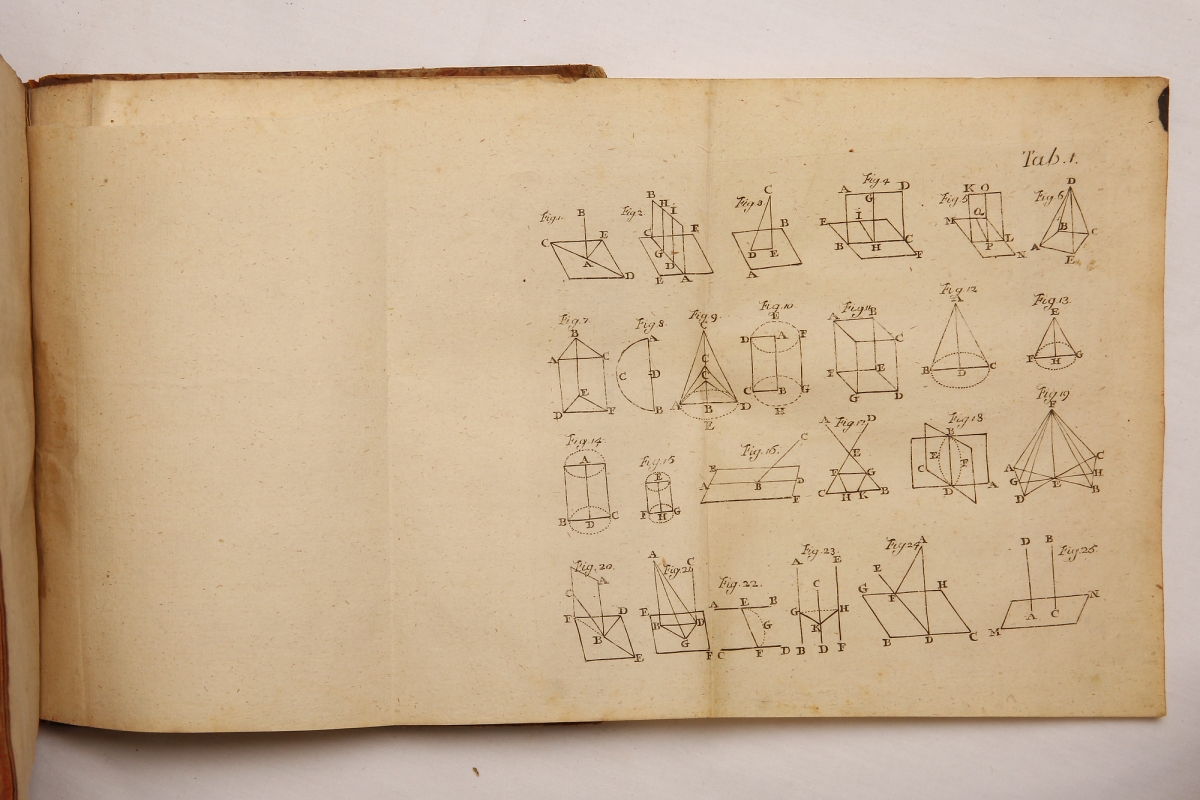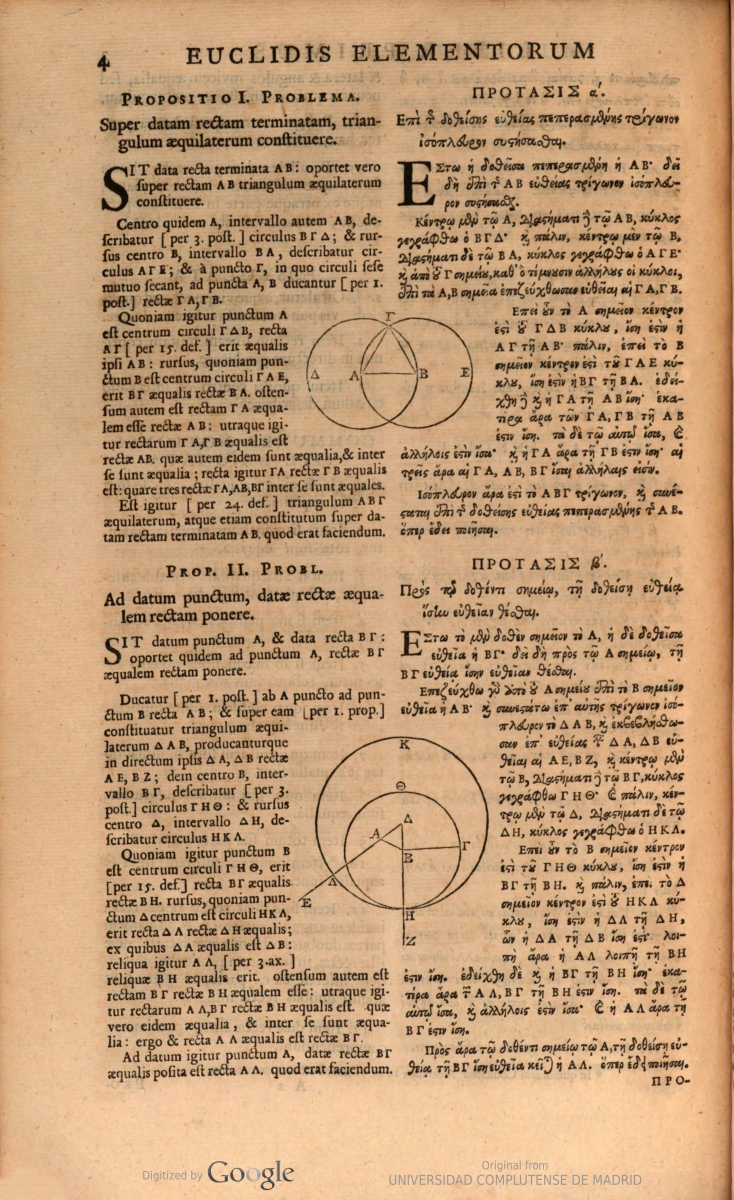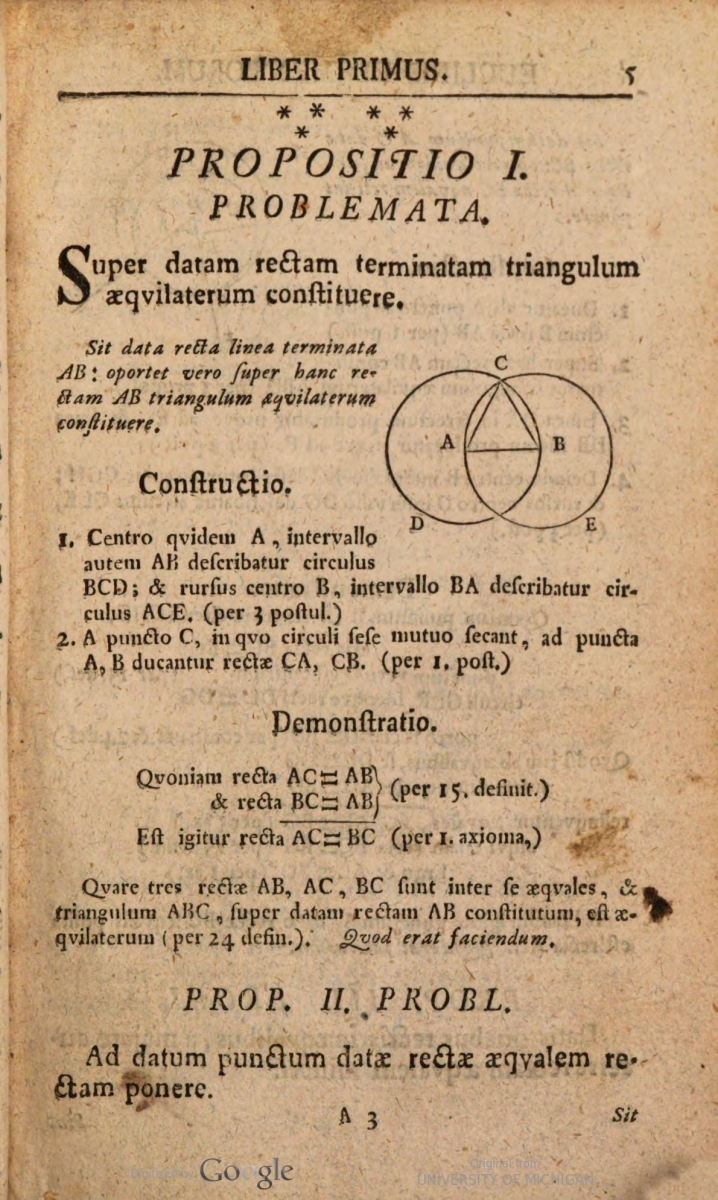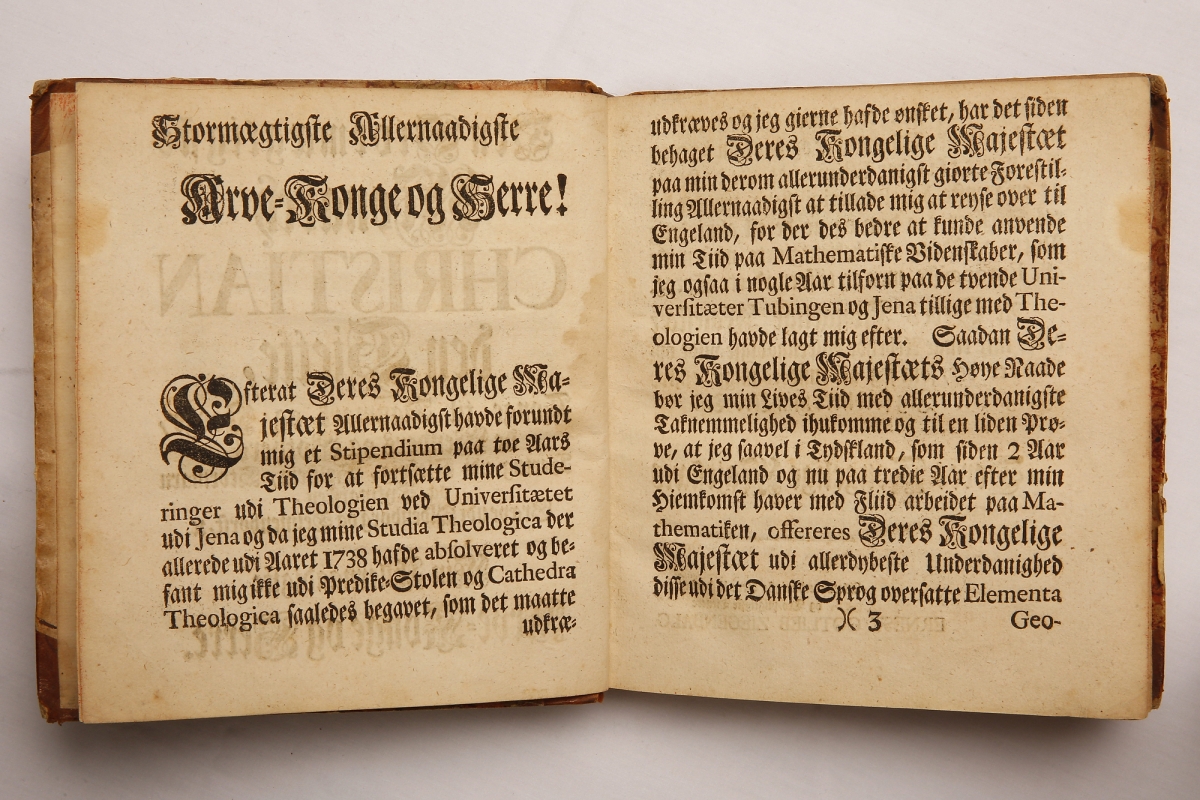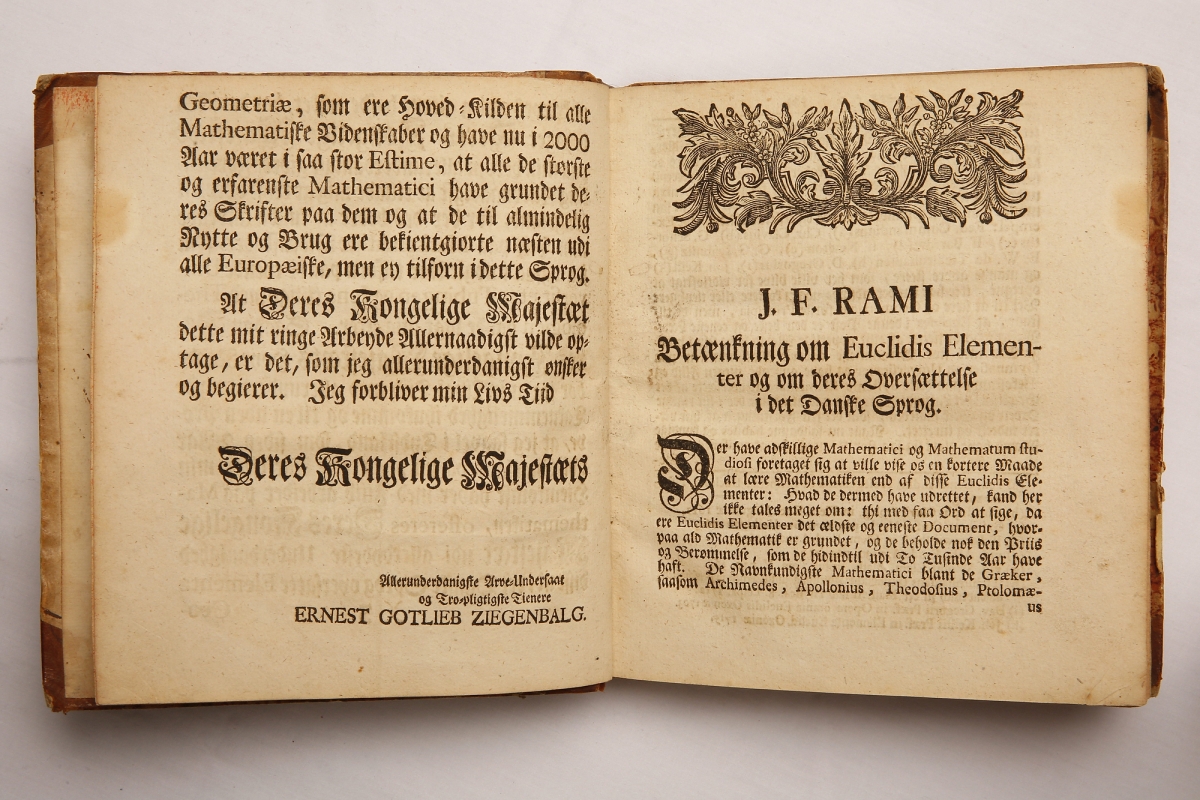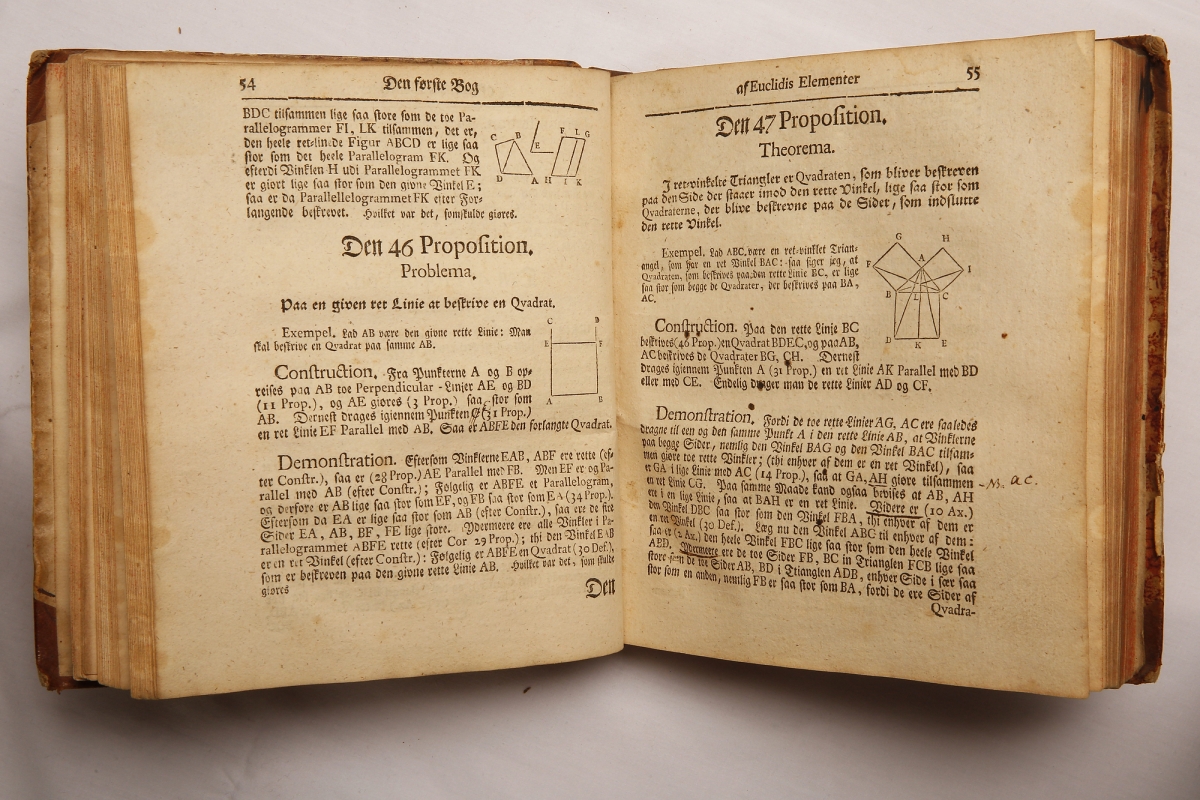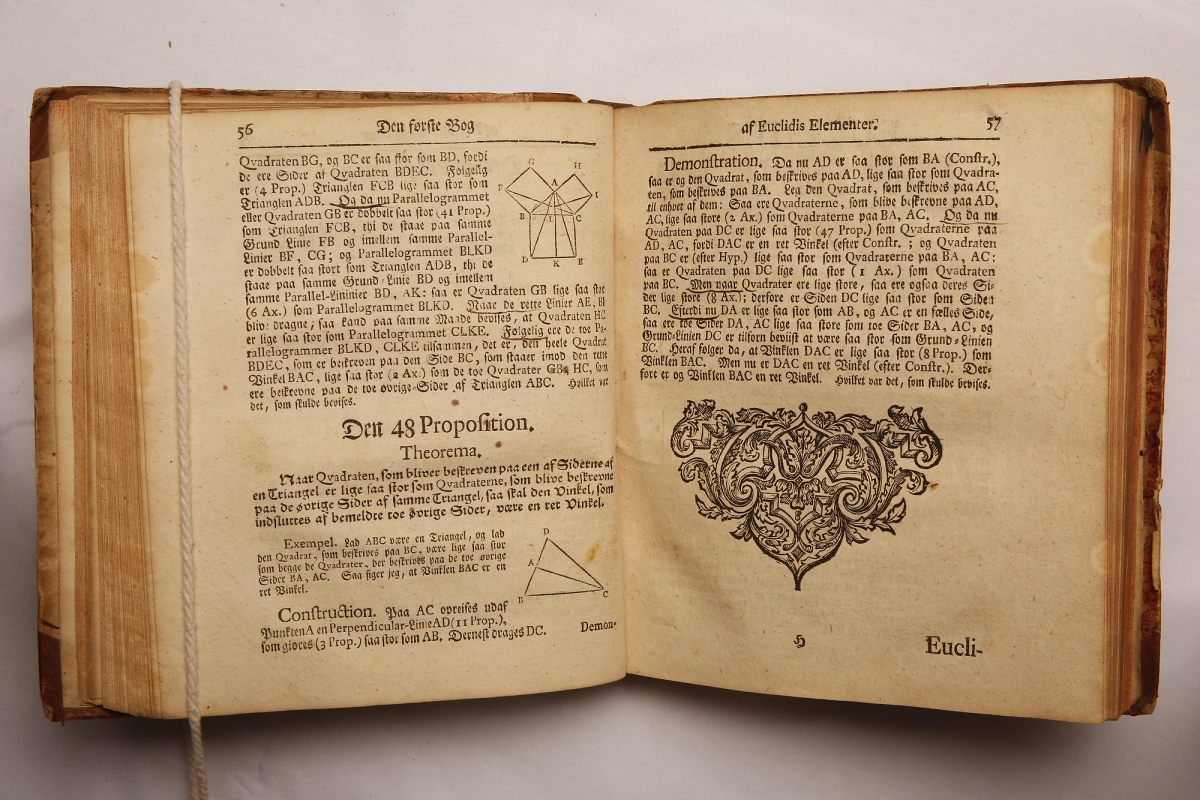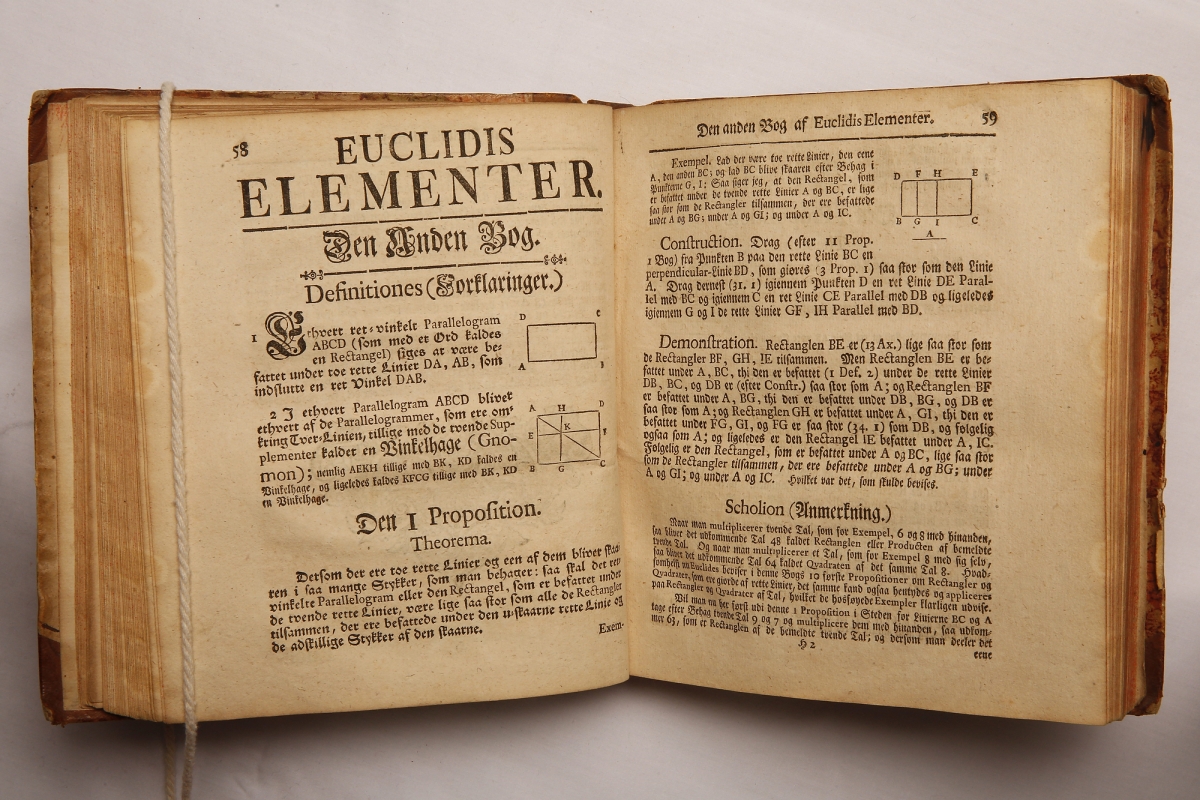E. G. Ziegenbalg’s Danish Translation of Euclid’s Elements
As Latin ceased to be the language of mathematical discourse in early modern Europe, classic texts needed to be translated into the various vernacular languages. For instance, the first translation of Euclid’s Elements into the Danish language appeared in 1744[1] under the title Euclidis elementa geometriæ, det er, Første Grund til Geometrien, i det danske Sprog oversat (Euclid’s Elements of Geometry, That is, the Foundation of Geometry, Translated into the Danish Language). This brief article introduces the translator, Ernest Gotlieb Ziegenbalg[2] (1716–1758), who is likely little-known, not only among the readers of Convergence but perhaps also to historians of Scandinavian science. Additionally, I highlight some notable characteristics of the printed volume as well as of the copy in my library. The book is a beautiful production with a distinctive formatting style aimed at sensibly presenting the material to students learning geometry. As such, the book not only naturally belongs among Convergence’s Mathematical Treasures, but also deserves attention for its pedagogical approach to presenting Euclid’s Elements to students.
Figure 1. The first page of Ziegenbalg’s translation of Euclid’s Elements. All photos of the book in this article show
the author’s personal copy and were taken by Michael Forster Rothbart.
[2] Elsewhere other forms of the name, including Latinized ones, are used, such as Gottlieb Ernst Ziegenbalg [e.g., Jeyaraj 2019], Ernst Gottlieb Ziegenbalg [e.g., Nielsen 1912], Ernestus Gottlieb Ziegenbalg [e.g., Worm 1773, 643], and Ernestus Theophilus Ziegenbalg [e.g., Walchio and Ziegenbalg 1738].
E. G. Ziegenbalg’s Danish Translation of Euclid’s Elements: Ziegenbalg’s Life and Career
Not much is known about Ziegenbalg’s life.[3] His father was the German Pietist preacher, missionary, and proto-Indologist Bartholomäus Ziegenbalg (1682 or 1683–1719).[4] His mother was Maria Dorothea Ziegenbalg (née Salzmann) (b. 1696). At the call of King Frederick IV of Denmark–Norway (r. 1699–1730), Bartholomäus Ziegenbalg worked as a missionary in Tranquebar, a Danish colony on the Coromandel Coast (now Tharangambadi in Tamil Nadu, India), from 1706 to 1714. He married Maria Dorothea in Germany in 1715, and in 1716 returned to Tranquebar with her. After the death of Bartholomäus Ziegenbalg in 1719, Maria Dorothea married Oluf Lygaard (1691–1741), the Deputy Commandant of Tranquebar, in 1720. The family moved to Copenhagen in 1721.[5]
E. G. Ziegenbalg was born in 1716. Several sources state that he was born on the ship during his parents’ journey to India,[6] though Jeyaraj [2019, 116] holds that he was born after his parents’ arrival in Tranquebar. After his mother’s marriage to Oluf Lygaard in 1720, he moved with them to Copenhagen in 1721.
In the preface to his translation of the Elements, Ziegenbalg described his education: A two-year stipend from King Christian VI of Denmark–Norway (r. 1730–1746) allowed him to study theology at the university in Jena in Germany. After completing his studies in Jena in 1738, he felt that he lacked the necessary talent to be a pastor or hold an academic chair in theology. King Christian VI then allowed him to spend two years in England to study the mathematical sciences, a subject he was interested in and had studied previously at the universities in Tübingen (see below) and Jena. Ziegenbalg wrote that he worked diligently on mathematics while he was at the universities in Tübingen and Jena, during his two years in England, and for another three years after his return (to Denmark, presumably). As the culmination of these many years of studying mathematics, Ziegenbalg dedicated his translation of Euclid’s Elements to King Christian VI.
The records of the University of Tübingen [Bürk and Wille 1953, 98] show that Ziegenbalg was part of a group of pupils from the monastic school at Maulbronn Monastery in Baden-Württemberg, Germany, who matriculated on 26 October 1735. Ziegenbalg received a stipend (on the grounds that his father had passed away) to the Tübinger Stift. The Tübinger Stift, which has a close relationship to the University of Tübingen, is a “study house” offering room, board, and coursework to prospective pastors and teachers that is owned by the Evangelical-Lutheran Church in Württemberg. On 21 November 1735, Ziegenbalg was awarded a baccalaureate degree. He was dismissed from the Tübinger Stift in 1736. It is not clear why he was dismissed, but it was presumably because he was awarded a royal stipend from Denmark to study theology at the university in Jena.
It is possible that Ziegenbalg’s interest in mathematics was kindled by the lectures of Johann Conrad Creiling (1673–1752) at the University of Tübingen.[7] According to the University of Tübingen’s Ordo studiorum (a list of courses offered at the university) for 1734, Creiling offered instruction in mathematics at the university.[8] More specifically, Creiling offered to read parts of Wolffi Epitomen with interested students. Wolffi Epitomen must refer to Christian Wolff’s Elementa matheseos universae (1713–1715). As we will see in a later section, Ziegenbalg referred to the Danish translation of the German version of this text (Wolff published both a German and a Latin version).
Ziegenbalg matriculated at the University of Jena on 2 November 1736 [Köhler 1992, 284]. At Jena, he studied under the Lutheran theologian Johann Georg Walch (1693–1775). On 11 October 1738, Ziegenbalg defended a thesis written by Walch, entitled Historia transsubstantiationis pontificiae [Walchio and Ziegenbalg 1738]. Such a defense was not an unusual exercise for an advanced student of theology at the time. The thesis is dedicated to Johan Ludvig Holstein (1694–1763), a Danish aristocrat who served as prime minister of Denmark from 1735 to 1751 and in 1742 was one of the founders of the Royal Danish Academy of Sciences and Letters. Holstein had influence in the College of Missions, which controlled the Danish mission in Tranquebar. He was also, like Ziegenbalg’s father, a Pietist. It is possible that the funding for Ziegenbalg’s studies in Germany and England came from Holstein or from funds controlled by him.
It is unclear where in England Ziegenbalg studied mathematics. Hirsching [1794–1815, xvii:126] states that Ziegenbalg stayed in Oxford for seven years (a span considerably longer than the two years Ziegenbalg himself says he spent in England), but Jeyaraj [2019, 117] says he studied mathematics in London. The University of Oxford has no record that Ziegenbalg matriculated there [Foster 1888], though it is possible that he studied informally in Oxford with a tutor. Christensen [1895, 169] notes that Ziegenbalg visited schools for craftsmen in London, which means he must have spent time in that city.
As noted above, Ziegenbalg wrote in the preface to his translation of Euclid that he worked on mathematics in Germany, during his two years in England, and for another three years after his return to Denmark. Since the translation was published in 1744, Ziegenbalg must have returned to Denmark from England around 1741, which is consistent with the fact that he completed his studies in Jena in 1738. That Ziegenbalg was in Denmark in 1741 follows from a note in [Æreboe 1889, 34, fn. 1] that he applied to succeed his stepfather Oluf Lygaard, who passed away that year, as manager of stamped paper (stempelpapirforvalter). In Copenhagen, Ziegenbalg met with German Lutheran missionaries, who would stay in the city for a while before traveling to Tranquebar. The missionaries held Bartholomäus Ziegenbalg and his missionary methods in high regard and are said to have appreciated meeting his son [Jeyaraj 2019, 117].
In 1747, Joachim Frederik Ramus (1685 or 1686–1769),[9] who was professor of mathematics at the University of Copenhagen and Ziegenbalg’s mentor, was given an exemption from lecturing. Ziegenbalg became Ramus’ substitute and delivered the mathematical lectures at the university. He was also appointed “designated professor” (designeret professor); that is, he was named as Ramus’ successor. But Ziegenbalg passed away before Ramus, and therefore he never held a professorship in mathematics at the University of Copenhagen.[10] Ziegenbalg wrote two university programs (public announcements issued by the rector of the University of Copenhagen) in Latin in 1755 [Nielsen 1912, 220], one on the usefulness of geometry, entitled De utilitate geometriæ,[11] and the other entitled De præcipuis frigoris qualitatibus et effectibus (On the Special Qualities and Effects of Cold).
Also in 1747, Ziegenbalg became a member of the Royal Danish Academy of Sciences and Letters. He published three treatises in the proceedings of the Academy [Nielsen 1912, 220]: Observationer, som ere gjorte over Veyrliget og Vindene i Kiøbenhavn fra Dec. 1745 til Juni 1748, samt kort Afhandling om slige Observations Nytte (Observations, which are Made of the Weather and Winds in Copenhagen from December 1745 to June 1748, as well as a Brief Treatise on these Observations’ Usefulness); En Merkværdig Egenskab, funden hos Snegle (A Peculiar Characteristic Found in Snails); and Aarsagen til Iis (The Cause of Ice).
Ziegenbalg passed away on 17 June 1758 at the age of 41 or 42. (Although according to Hirsching [1794–1815, xvii:126], the date was 17 June 1759.) Poggendorff [1863, ii:1408] writes that Ziegenbalg died in Copenhagen.
The Danish translation of Euclid was Ziegenbalg’s only written contribution to mathematics. The fact that his other publications were on different subjects than mathematics is peculiar, but also typical for a time when many scholars were polymaths. As a result, it is not possible to assess Ziegenbalg’s mathematical talent. Christensen [1895, 214] assumes that Ziegenbalg, who left theology to pursue his interest in mathematics, must have had some mathematical ability. But as Nielsen [1912, 264] notes, the only thing that can be said with certainty is that he was insignificant as a mathematical writer.
Ziegenbalg’s translation never appeared in a second edition or printing. Hans Christian Linderup, who taught mathematics at Metropolitanskolen (at the time a prestigious secondary school in Copenhagen), wrote that he decided to publish a new translation of the Elements because it was difficult for his students to find copies of Ziegenbalg’s translation [Linderup 1803, preface]. Linderup’s translation, the second translation of Euclid’s Elements into Danish, was published in 1803 (the translation covers Books 1–6, translated from the Greek text of [Gregory 1703]).
[3] The following account is drawn from Worm [1773, ii:643–644]; Hirsching [1794–1815, xvii:126]; Nyerup and Kraft [1820, 685]; Poggendorff [1863, ii:1408]; Christensen [1895, 214 and passim]; Nielsen [1912, 220 and passim]; and Jeyaraj [2019].
[4] See [Sweetman 2003, 104–126] for an account of Bartholomäus Ziegenbalg’s life, missionary work, and contributions to Indology. Sweetman [2003, 107] and Jeyaraj [2006, 1] give 1682 as the birthyear of Bartholomäus Ziegenbalg, whereas Nyerup and Kraft [1820, 685] give 1683.
[5] The years of Maria Dorothea’s birth, marriage to Bartholomäus Ziegenbalg, journey to India, marriage to Oluf Lygaard, and journey to Copenhagen are all recorded in an engraving from 1737 by Johann Jacob Haid, which is kept at the Royal Danish Library and available online at http://www5.kb.dk/images/billed/2010/okt/billeder/object396288/da (accessed 14 March 2023). Jeyaraj [2019, 101] states that Maria Dorothea was born in c. 1693. It is not clear when Maria Dorothea passed away. A note in [Æreboe 1889, 33–34, fn. 1] states that she was alive in 1741, when her second husband, Oluf Lygaard, passed away. Furthermore, a son of Lygaard and Maria Dorothea named Johannes Jacobus (Johan Jacob) Lygaard was born in Copenhagen in 1739, but attended school in Flensburg (then a city in the Duchy of Schleswig, a part of Denmark–Norway, but now in Germany) from 1750, see [Achelis 1966, 344]. Maria Dorothea must have relocated to Flensburg after the death of Oluf Lygaard in 1741. Jeyaraj [2019] gives an account of the life of Maria Dorothea Ziegenbalg. However, it is incorrectly stated in that account that Maria Dorothea passed away in 1722, and that Oluf Lygaard passed away before her within a year after the family’s arrival in Copenhagen ([Jeyaraj 2019, 116]).
[6] Worm [1773, ii:643], Nyerup and Kraft [1820, 685], Poggendorff [1863, 1408], and Christensen [1895, 214] state that Ziegenbalg was born on the ship.
[7] For information about Creiling, see [Betsch 2005].
[8] The Ordo studiorum for 1734 is available online at http://idb.ub.uni-tuebingen.de/opendigi/LXV19_fol_1734 (accessed on 29 August 2021). Unfortunately, the Ordo studiorum for 1735 and 1736 are not available, but the one for 1737 can be found online at http://idb.ub.uni-tuebingen.de/opendigi/LXV19_fol_1737 (accessed 29 August 2021).
[9] For information on Ramus, see for example [Nielsen 1912, 163–164 and passim].
[10] Glunk et al. [2021, 45] and Jeyaraj [2019, 117] incorrectly state that Ziegenbalg was professor of mathematics at the University of Copenhagen.
[11] The copy of De utilitate geometriæ in the Royal Danish Library is unfortunately lost (personal communication from the Royal Danish Library, 16 June 2021).
E. G. Ziegenbalg’s Danish Translation of Euclid’s Elements: The Translation’s Structure and Source Material
Euclidis elementa geometriæ, which Ziegenbalg dedicated to King Christian VI of Denmark–Norway, is a beautiful book. Glunk et al. [2021, 45] notes that the book’s layout bears witness to an expensive production with a clear organization of the text: for each proposition, the book’s typography keeps the statement of the proposition, the example, the demonstration, and the conclusion separate, and places the figure where it can be easily referenced by the reader (see, for example, Figure 8 below, where the figure for proposition 1.47, which spans two pages, is printed on both pages). This distinctive formatting style is, in fact, due to Ramus, and will be discussed in the next section. The book measures 17.5 cm by 19.5 cm, and has a convenient size and weight for being easily carried around by a student. As noted by Glunk et al. [2021, 45], as was typical for the time, the book has a Latin title, which is explained in Danish in the subtitle, but otherwise the entire book is in Danish.
The book contains the following:
- A preface by Ziegenbalg, 3 unpaginated pages.
- An introduction by J. F. Ramus, 6 unpaginated pages.
- An introduction by Ziegenbalg, paginated 1–19 (first page unpaginated).
- A page of errata, unpaginated.
- The Danish translation of Books 1–6 and 11–12 of the Elements, paginated 1–311 (first page unpaginated).
- Five fold-out plates with geometrical diagrams.
The eight books translated by Ziegenbalg cover plane geometry (Book 1–4), ratio and proportion (Book 5), application of proportions to plane geometry (Book 6), and basic solid geometry (Books 11–12).
Figure 2. Ziegenbalg’s dedication to King Christian VI of Denmark–Norway.
Ziegenbalg does not tell his readers which edition of the Elements his Danish translation is based on, but it is likely Ramus’ Latin edition from 1740 for Books 1–6. Ramus published two Latin editions of Books 1–6 of the Elements: one in 1737, entitled Elementa geometriæ VI prioribus libris Euclidis comprehensa [Ramus 1737], and another in 1740, entitled Euclidis elementa geometriæ planæ libris VI comprehensa [Ramus 1740]. The latter, which appeared in a second edition in 1756 [Ramus 1756], was meant for school use. Christensen [1895, 97] notes that Ziegenbalg’s translation was used as a textbook at the University of Copenhagen, so it is reasonable to assume that it was based on his mentor’s edition aimed at school use. (Christensen [1895, 42] notes also that Ziegenbalg’s translation of Euclid was written as much for teachers as for students.) There are differences between Ramus’ 1756 edition and Ziegenbalg’s translation, however.[12] To give an example, Figure 3 shows that Ziegenbalg includes figures for Definitions 4.1 and 4.3 that are not found in [Ramus 1756].
Figure 3. The definitions of Book 4 in Ramus 1756 (top, from HathiTrust) and Ziegenbalg 1744 (bottom).
Books 11–12 are not included in any of Ramus’ editions. Ziegenbalg could have used Gregory [1703] or Tacquet [1722] for his translation of these two books; the former was used by Ramus for his 1740 edition [Christensen 1895, 40], and Ziegenbalg mentions the latter explicitly in the introduction to his translation of the Elements. (For more on Ziegenbalg’s use of Tacquet, see below.) Ramus’ distinctive formatting style for proofs (see below) is followed throughout the translation, including in Books 11–12 (it is not used by Gregory or Tacquet).
Figure 4. Proposition 13 of Book 5.
Figure 5. Fold-out plate with figures.
[12] Unfortunately, I have not been able to inspect a copy of [Ramus 1740].
E. G. Ziegenbalg’s Danish Translation of Euclid’s Elements: The Influence of Ramus
Ramus was professor of mathematics at the University of Copenhagen from 1722 to his death in 1769. As discussed above, he published Latin editions of the Elements in 1737 and 1740. The latter, which was meant for school use, appeared in a second edition in 1756. According to Christensen [1895, 40], the 1740 edition followed the text and arrangement of the Oxford edition [Gregory 1703] without deviation, but Ramus made use of different fonts, spacing, and headings to set up the text in a manner beneficial for a textbook:
- First the proposition is stated.
- Next the proposition is restated with reference to a figure.
- Then, under the heading constructio, the diagram for the proof is constructed, if applicable.
- Finally, under the heading demonstratio, the proof of the proposition is given.
The typography and formatting appear to be unusual for the time, and possibly also for the location, but further research is needed to determine whether this distinctive style is due to Ramus or predates him.
The formatting style is followed in Ramus’ 1756 edition as well. Figure 6 contrasts Proposition 1.1 in Gregory [1703] and Ramus [1756]. As can be seen, the text in Ramus’ 1756 edition differs from Gregory’s text, suggesting Ramus made changes from his first edition, since Christensen [1895, 40] stated that, even though Ramus changed the formatting style, there were no differences between the texts of Gregory [1703] and Ramus [1740].
Figure 6. Proposition 1.1 in Gregory 1703 (left, HathiTrust) and Ramus 1756 (right, HathiTrust).
The praise of Euclid in Ramus’ introduction to Ziegenbalg’s Euclid translation is even more emphatic than Ziegenbalg’s own praise in his preface (see the next page):
Der have adskillige Mathematici og Mathematum studiosi foretaget sig at ville vise os en kortere Maade at lære Mathematiken end af disse Euclidis Elementer: Hvad de dermed have udrettet, kand her ikke tales meget om: thi med faa Ord at sige, da ere Euclidis Elementer det ældste og eeneste Document, hvorpaa ald Mathematik er grundet, og de beholde nok den Priis og Berømmelse, som de hidindtil udi To Tusinde Aar have haft.
Several mathematicians and students of mathematics have attempted to show us a shorter way to learn mathematics than from these Euclid’s Elements. Not much can be said here about what they accomplished thereby. To put it briefly, Euclid’s Elements are the oldest and only document upon which all mathematics is founded, and they will probably keep the praise and fame, which they have had up to today for two thousand years.
Ramus noted the practical value of the Elements for military and civilian purposes, emphasizing its importance for engineers, sailors, master builders, opticians, and other skilled professionals. The availability of a Danish translation of the Elements is essential, Ramus argued, for it allowed talented people to use the text without the need to devote time to learn Latin. He further noted the difficulties in preparing such a translation: the translator must not only master both Latin and geometry, but also be able to express the material in a clear and precise way in the Danish language. He praised Ziegenbalg’s translation and stated that Ziegenbalg had earned the fame of being the first to prepare a Danish translation of the Elements. In general, Christensen [1895, 41] notes that Ramus’ introduction does not contain anything not found in his Latin edition of the Elements.
E. G. Ziegenbalg’s Danish Translation of Euclid’s Elements: Ziegenbalg’s Preface and Introduction
In his preface, Ziegenbalg reiterated his gratitude to King Christian VI, gave information about his (Ziegenbalg’s) academic studies, and praised the Elements as “the main source of all mathematical sciences and the basis of the writings of the greatest and most experienced mathematicians.”
Figure 7. Ziegenbalg’s preface, addressed to King Christian VI (top and bottom left),
and the beginning of Ramus’ introduction as reprinted by Ziegenbalg (bottom right).
In his introduction, Ziegenbalg explained that he chose to omit Books 7–10 from the translation because they deal with numbers rather than geometry. For an account of the nature of mathematics, he referred the reader to the 1741 Danish translation [Wolff 1741][13] of Christian Wolff’s (1679–1754) Der Anfangs-Gründe aller mathematischen Wissenschafften from 1710. At the time, there was no account in Danish of the origin and development of mathematics, so Ziegenbalg included a Danish translation of André Tacquet’s (1612–1660) account of the history of mathematics from the earliest times. Next, Ziegenbalg provided a discussion of the structure and teaching method of the Elements, including how his translation was arranged. Ziegenbalg’s arrangement of the text, as explicitly described in the introduction and as can be seen throughout the book, is identical to that used by Ramus, described on the previous page. Ziegenbalg called the second part of Ramus’ formatting, which Ramus did not label in [Ramus 1756], Exempel, “example.” That is, it is a restating of the proposition with reference to a particular figure (the example). He called the third and fourth parts Construction and Demonstration, respectively. The arrangement can be seen, for example, in Figure 9, which shows Proposition 2.1. Finally, he summarized each of Books 1–6 and 11–12. Ziegenbalg noted that the summaries were based on similar summaries in the edition of Tacquet’s Elementa geometriae published in 1722 in Cambridge [Tacquet 1722], which is also where Ziegenbalg found Tacquet's essay on the origin of mathematics.
Figure 8. Propositions 1.46–48, including the Pythagorean theorem (Proposition 1.47).
Figure 9. The beginning of Book 2.
E. G. Ziegenbalg’s Danish Translation of Euclid’s Elements: Provenance of This Copy
The ownership history of the author’s copy of Ziegenbalg’s translation of the Elements is of interest and worth sharing here. An inscription at the beginning of the book shows that it belonged to a P. L. Quisling in 1747 (look above the book title in Figure 1).
Quisling is a Norwegian family name that traces its origin to Lauritz Ibsen Quislin (1634–1703), who as a young man moved to Norway from Kvislemark in Denmark.[14] The name Quisling derives from the placename Kvislemark. Through the generations, many members of the family became pastors. Today, the name Quisling is inextricably linked to Vidkun Quisling (1887–1945), a Norwegian politician and Nazi collaborator, who was executed in 1945 after the end of World War II. Even during Vidkun Quisling’s lifetime, the term “quisling” was used in English to mean a traitor or collaborator.
P. L. Quisling is probably Peder Larsson Qvislin, one of the sons of the pastor Lauritz Abrahamsson Qvislin (d. 1756).[15] In 1748, at the age of 21, Peder matriculated at the University of Copenhagen, where he is listed as Petrus Quislin [Birket-Smith 1912, 84].
An inscription on the back of the last fold-out plate in the book provides another name: A. L. Quisling (see Figure 10). A. L. Quisling was probably Peder’s younger brother Abraham Larsson Qvislin. In 1749, also at the age of 21, Abraham matriculated at the University of Copenhagen, where he is listed as Abrahamus Quislin [Birket-Smith 1912, 95]. The brothers’ sister Susanne was the great-great-grandmother of Vidkun Quisling.
It has been generally accepted that Lars Abraham Qvisling (1816–1876), the grandfather of Vidkun Quisling, was the first to add a final "g" to the name Qvislin [Ormtveit 1993, 9 and 37]. However, the two inscriptions in the author’s book by earlier members of the Quisling family show that a final "g" was used much earlier than that.
A third inscription shows that the book belonged to a Jørres Schjelderup Hansen in 1832 (see the top right corner of the left-hand page in Figure 1), which must be the Norwegian pastor and politician Jørres Schjelderup Hansen (1811–1870) [Lindstøl 1914, 339].
The line Dend som mig føder, “The one who births me,” is written twice next to (and perpendicular to) the name A. L. Quisling (see Figure 10). The line, which is the beginning of a hymn, was at the time commonly used as a pen trial (probatio pennae). That is, the line was commonly written when people were testing a new pen (much like the urban legend that guitarists play “Smoke on the Water” when trying out a new guitar). In fact, the Danish-Norwegian playwright Ludvig Holberg (1684–1754) mentions the line as a pen trial in the comedy Uden hoved og hale (Without Head or Tail) from 1723 [Holberg 1897–1909, vi:139]. In other words, the repetition of the line simply indicates that someone, perhaps Abraham Larsson Qvislin, was testing a pen before starting to write.[16]
Some marginal notes and underlining of words in the text are found only in Book 1 and in Proposition 2.6. The rest of the book appears to be unused, consistent with Christensen’s comment that students back then hardly would have gotten through more than Book 1 due to time constraints [Christensen 1895, 41]. Similarly, Cajori [1924, 137] notes that in medieval Europe, examinations in mathematics—if held at all—probably did not extend beyond Book 1 of the Elements. For that reason, the Pythagorean theorem, which with its converse concludes Book 1, was nicknamed Magister Matheseos (Master of Mathematics).
Figure 10. Inscription with the name A. L. Qvisling and the line Dend som mig føder, the latter written twice.
[14] For the Quisling family, see the wiki page maintained by the Norwegian Institute of Local History at the National Library of Norway at https://lokalhistoriewiki.no/wiki/Quisling (accessed 29 August 2021). See also [Ormtveit 1993].
[15] For information about Lauritz Qvislin and his children, see [Ormtveit 1993, 29–30].
[16] For an extensive discussion of the line Dend som mig føder, see [Frederiksen 2001].
E. G. Ziegenbalg’s Danish Translation of Euclid’s Elements: Conclusion
Vernacular editions of Euclid's Elements began to appear in the mid-sixteenth century [Wardhaugh 2021, 76]. In 1744, E. G. Ziegenbalg’s Danish translation of the Elements gave Denmark and Norway their first vernacular edition. The edition covers Books 1–6 and 11–12; that an edition of Euclid covered only these eight books was not unusual [Wardhaugh 2021, 76].
The effort to bring out a Danish translation of the Elements was not only due to Ziegenbalg's interest in the text and efforts to translate it. The emphasis on the value of vernacular editions in Ramus' introduction reveals that the mathematical community in Copenhagen at the time felt a need to have such an edition available in Denmark–Norway. Ramus himself had previously translated a work by Christian Wolff from German to Danish, which demonstrates his interest in making texts on mathematics available in Danish. The book production of Ziegenbalg's translation, with its distinct typography based on the organization of the text in Ramus' 1740 Latin edition of the Elements, shows that funding was available for such a project. The funding possibly came from the royal court, which had supported Ziegenbalg's studies for some time (note in particular Ziegenbalg's enthusiastic praise of King Christian VI).
The preface and introductions in Ziegenbalg's Danish edition shed light on the material available to the mathematicians in Copenhagen studying and translating Euclid's Elements into Danish. Besides the Latin editions of Ramus, the editions of Gregory [1703] and Tacquet [1722] were available, as were works by Christian Wolff. The presence of these works in Copenhagen offers clues to the connections the mathematicians at the University of Copenhagen had with mathematicians elsewhere.
Ziegenbalg's translation is—and was used as—a textbook. The carefully considered organization of the text makes the book a noteworthy teaching tool. It shows us how Ramus and his mentee Ziegenbalg envisioned how the material in Euclid should be taught to students. Both Ramus and Ziegenbalg saw Euclid's Elements as the foundation and source of all mathematics, and, given the importance of mathematics in other pursuits, they saw value in having a segment of the population understand Euclid. Such an understanding among a broader group of people would be better facilitated by a Danish edition with a pedagogical approach.
The physical book of Ziegenbalg's edition of Euclid’s Elements thus provides us with a window into an episode in the history of the Elements. It belongs with our Mathematical Treasures. Perhaps even today its contents can inspire us to contemplate how to best teach mathematics.
E. G. Ziegenbalg’s Danish Translation of Euclid’s Elements: Acknowledgements and About the Author
Acknowledgements
For their valuable help and suggestions, I am thankful to Gerhard Betsch, University of Tübingen; Jens Høyrup, Roskilde University; Niklas Thode Jensen, Danish National Archives; Sean Kelley, University of Essex; Jesper Lützen, University of Copenhagen; and Laura Søvsø Thomasen, Royal Danish Library.
About the Author
Toke Lindegaard Knudsen is an Associate Professor of Mathematics at the State University of New York at Oneonta. He teaches SUNY Oneonta’s course on the history of mathematics, which is aimed at students preparing to be high school mathematics teachers. He is passionate about introducing the students to the history of mathematics education, especially the local history of SUNY Oneonta. His research has mainly focused on mathematical astronomy and cosmography in ancient and medieval India
E. G. Ziegenbalg’s Danish Translation of Euclid’s Elements: References
Achelis, T. O. 1966. Matrikel der Schleswigschen Studenten 1517–1864. Volume II: 1741–1864. Copenhagen: G. E. C. Gads Verlag.
Æreboe, R. 1889. Notarius publicus Rasmus Æreboes autobiografi (1685–1744). Published by G. L. Grove. Copenhagen: Gyldendalske Boghandel. Additional digitization in HathiTrust.
Betsch, G. 2005. Johann Conrad Creiling (1673–1752) und seine Schule. In Mathesis, Naturphilosophie und Arkanwissenschaft im Umkreis Friedrich Christoph Oetingers (1702–1782), edited by S. Holtz, G. Betsch & E. Zwink, 43–59. Stuttgart: F. Steiner.
Birket-Smith, S. 1912. Kjøbenhavns Universitets Matrikel. Volume 3: 1740–1829. Copenhagen: H. Hagerup’s Boghandel.
Bürk, A., and W. Wille. 1953. Die Matrikeln der Universität Tübingen. Volume 3: 1710–1817. Stuttgart: Universitätsbibliothek Tübingen.
Cajori, F. 1924. A History of Elementary Mathematics: With Hints on Methods of Teaching. Revised and enlarged edition. New York: The Macmillan Company.
Christensen, S. A. 1895. Matematikens udvikling i Danmark og Norge i det XVIII. aarhundrede: en matematisk-historisk undersøgelse. Odense: Hempelske Boghandels Forlag.
Foster, J. 1888. Alumni oxonienses: the members of the University of Oxford, 1715–1886. 4 volumes. Oxford: Parker and Co.
Frederiksen, B. O. 2001. »Dend som mig føder« – en kommentar om kommentarer. Danske Studier 2001, 170–174.
Glunk, C., H. E. Strand, C. M. Taisbak, and C. G. Tortzen. 2021. Euklid, Elementer, Bog I–VI, Plangeometri. Gyldendal.
Gregory, D. 1703. Eukleidou ta sōzomena = Euclidis quæ supersunt omnia. Oxford: E Theatro Sheldoniano.
Heath, T. L. 1926. The thirteen books of Euclid's Elements: Translated from the text of Heiberg with introduction and commentary. Second revised edition. 3 volumes. Cambridge: The University Press.
Hirsching, F. K. G. 1794–1815. Historischliterarisches Handbuch berühmter und denkwürdigen Personen, welche in dem 18. Jahrhunderte gestorben sind. 17 volumes. Leipzig.
Holberg, L., and J. Martensen. 1897–1909. Komedier. Copenhagen.
Jeyaraj, D. 2006. Bartholomäus Ziegenbalg, the father of modern protestant mission: an Indian assessment. Delhi: Indian Society for Promoting Christian Knowledge; Chennai: The Gurukul Lutheran Theological College and Research Institute.
Jeyaraj, D. 2019. Maria Dorothea Ziegenbalg, the First German Lutheran Female Missionary to the Tamil People in South India. International Journal of Asian Christianity 2: 101–121.
Köhler, O. 1992. Die Matrikel der Universität Jena. Volume 3: 1723–1764. Munich, London, New York, Paris: K. G. Saur.
Linderup, H. C. 1803. De förste sex Böger af Euclidis Elementer til Brug i de forandrede lærde Skoler. Copenhagen: A. & S. Soldin.
Lindstøl, T. 1914–15. Stortinget og statsraadet, 1814–1914: efter offentlig foranstaltning utgit. Oslo. Additional digitization in HathiTrust.
Nielsen, N. 1912. Matematiken i Danmark, 1528–1800: Bidrag til en bibliografisk-historisk oversigt. Copenhagen and Oslo: Gyldendalske boghandel, Nordisk forlag.
Nyerup, R., and J. E. Kraft. 1820. Almindeligt litteraturlexicon for Danmark, Norge, og Island. Two volumes in one. Copenhagen: Gyldendalske boghandling.
Ormtveit, A. S. 1993. Quisling-saga: Ættesaga frå det 16. Århundre til 1945. Astrid S. Ormtveit.
Poggendorff, J. C. 1863. Biographisch-literarisches Handwörterbuch zur Geschichte der exacten Wissenschaften. 2 volumes. Leipzig: J. A. Barth.
Ramus, J. F. 1737. Elementa geometriæ VI prioribus libris Euclidis comprehensa, qvæ primam et præcipuam matheseos puræ partem constituunt. Copenhagen.
Ramus, J. F. 1740. Euclidis elementa geometriæ planæ libris VI comprehensa, in usum incipientium adornata. Copenhagen.
Ramus, J. F. 1756. Euclidis elementa geometriae planae libris VI comprehensa, in usum incipientium adornata. Altera editio, priore correctior. Copenhagen: J. G. Höpffneri.
Sweetman, W. 2003. Mapping Hinduism: 'Hinduism' and the study of Indian religions, 1600–1776. Halle: Franckesche Stiftungen.
Tacquet, A. 1722. Elementa Euclidea geometriæ planæ ac solidæ; et selecta ex Archimede theoremata. Edited by William Whiston. Cambridge: Impensis Corn. Crownfield; Jacobi Knapton.
Walchio, I. G., and E. T. Ziegenbalg. 1738. Historia transsubstantiationis pontificiae. Jena: Litteris Ritterianis.
Wardhaugh, B. 2021. Encounters with Euclid: How an Ancient Greek Text Shaped the World. Princeton and Oxford: Princeton University Press.
Wolff, C. 1741. Kort Begreb af den første Grund til alle mathematiske Videnskaber: Den første Deel indeholder den pure Mathematik, som bestaar udi Regnekunsten, Geometrien, Trigonometrien og Algebra. Copenhagen: Johan Jørgen Høpffner.
Worm, J. 1773. Forsøg til et lexicon over danske, norske og islandske herde mænd: som ved trykte skrifter have giort sig bekiendte, saavelsom andre ustuderede, som noget have skrevet, hvorudi deres fødsel, betydeligste levnets omsttendigheder og død ved aarstal kortelig erindres, og deres skrifter, saavidt mueligt. 3 volumes. Elsinore: Trykt i det Kongelig allene privilegerede Bogtrykkerie.
Ziegenbalg, E. G. 1744. Euclidis Elementa Geometriæ: Det er, Første Grund til Geometrien, I det danske Sprog oversat. Copenhagen: Ernst Henrich Berling.
